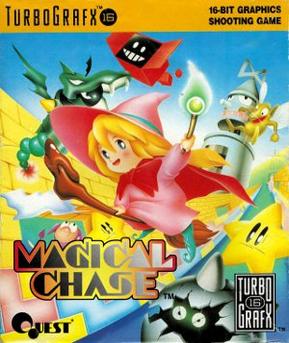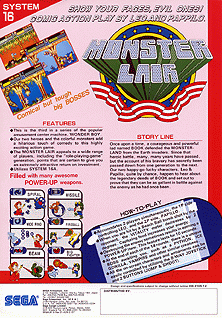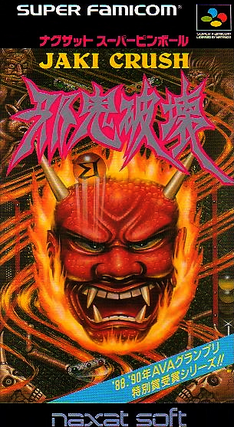
The TurboGrafx-16, known as the PC Engine outside North America, is a home video game console designed by Hudson Soft and sold by NEC Home Electronics. It was the first console marketed in the fourth generation, commonly known as the 16-bit era, however in actuality, the console has an 8-bit central processing unit (CPU) coupled with a 16-bit graphics processor, effectively making the claim somewhat false advertising. It was released in Japan in 1987 and in North America in 1989. In Europe the Japanese model was unofficially imported and distributed in the United Kingdom and France from 1988. In Japan, the system was launched as a competitor to the Famicom, but the delayed United States release meant that it ended up competing with the Sega Genesis and later the Super NES.

Salamander, retitled Life Force in North America and in the Japanese arcade re-release, is a scrolling shooter arcade video game developed and published by Konami. Released in 1986 as a spin-off of Gradius, Salamander introduced a simplified power-up system, two-player cooperative gameplay and both horizontally and vertically scrolling stages. Some of these later became normal for future Gradius games. In Japanese, the title is written using ateji, which are kanji used for spelling foreign words that has been supplanted in everyday use by katakana. Contra, another game by Konami was also given this treatment, with its title written in Japanese as 魂斗羅.

Wonder Boy III: The Dragon's Trap, known as Monster World II in Japan, is a platforming action-adventure video game developed by Westone as part of Sega's Wonder Boy series. It was published by Sega and released for the Master System in 1989 and for the Game Gear in 1992 as Wonder Boy: The Dragon's Trap. It was ported by Hudson Soft and released in 1991 for the TurboGrafx-16/PC Engine under the name Dragon's Curse. It was also ported in 1993 by Brazilian company Tec Toy under the title Turma da Mônica em o Resgate, with the game retooled to include characters from Brazilian comic book series Monica's Gang. A remake developed by Lizardcube and published by DotEmu, titled Wonder Boy: The Dragon's Trap, was released in April 2017.

Forgotten Worlds, originally titled Lost Worlds, is a side-scrolling shooter video game by Capcom, originally released as a coin-operated arcade game in 1988. It is notable for being the first title released by Capcom for their CP System arcade game hardware.

Magical Chase is a 1991 horizontally scrolling shooter video game developed by Quest and published by Palsoft and Turbo Technologies Inc. for the TurboGrafx-16. The game stars a young witch apprentice named Ripple, who broke a promise to her teacher by accidentally releasing six demons from a forbidden book, joined by her star companions Topsy and Turvy on a quest to catch and seal the demons back into the book.

Alien Crush is a pinball video game developed by Compile for the PC Engine/TurboGrafx-16. It was released in 1988. The game is the first installment in the Crush Pinball series. It was followed by three sequels, Devil's Crush, Jaki Crush, and Alien Crush Returns. Alien Crush was later re-released via emulation on the Virtual Console for Wii, 3DS, and Wii U, and for PlayStation 3 through PlayStation Network.

Air Buster is a 1990 horizontally scrolling shooter arcade video game developed by Kaneko. It was published by Namco in Japan and Sharp Image Electronics in North America. Two players control the "Blaster Fighter" star ships in their efforts to destroy a mysterious mechanical fortress orbiting Earth, with plans to take control of the planet. The Blaster Fighters can equip one of seven available weapons, which will change the ship's firepower and abilities, such as diagonal shots, homing missiles and small drones that follow the player's ship.

Bonk's Adventure, known as PC Genjin in Japan, PC Kid and B.C. Kid in Europe, is a scrolling platform game developed by Red Company and Atlus and released in 1989 in Japan and 1990 in North America for the PC Engine/TurboGrafx-16. The Japanese title PC Genjin is a play on the system's original name, PC Engine, with the European title PC Kid similarly referencing the system's name. The first game in the Bonk series, it was followed by two more games for the TurboGrafx-16 before branching out to other platforms.

Valis III is a 1990 action-platform video game originally developed by Laser Soft, published by Telenet Japan and NEC for the TurboGrafx-CD. A Sega Genesis version was released in 1991. It is the third entry in the Valis series. It stars Yuko Asou, a Japanese teenage schoolgirl chosen as the Valis warrior and wielder of the mystical Valis sword after the events of Valis II. King Glames, wielder of the sword Leethus, leads denizens of the dark world to conquer both Vecanti and Earth, seeking refuge for his people amid the destruction of their planet. Together with the demon warrior-maiden Cham and her sister Valna, Yuko must prevent Glames from destroying both worlds. Through the journey, the player explores and searches for items and power-ups while fighting enemies and defeating bosses.

Wonder Boy III: Monster Lair is a side-scrolling action game developed by Westone Bit Entertainment that was originally released for the arcades by Sega in 1988. It is the third game in the Wonder Boy series and the last one released for the arcade. A console adaptation was made by Hudson Soft, released in 1989 in Japan for the PC Engine CD-ROM² System and the subsequent North American release on the TurboGrafx-CD dropped the 'Wonder Boy III' title. It was also converted and released by Sega for the Mega Drive in Japan in 1990 and Europe in 1991. Both, the TurboGrafx-CD and Mega Drive versions have been re-released for the Wii Virtual Console.

Gunhed, known as Blazing Lazers in North America, is a vertically scrolling shooter game by Hudson Soft and Compile, based on the Japanese film Gunhed. The title was released in 1989, for the PC Engine in Japan and re-skinned for the TurboGrafx-16 in North America, with Gunhed unofficially imported for the PC Engine in Europe. In the game, a fictional galaxy is under attack by an enemy space armada called the Dark Squadron, and this galaxy's only chance for survival is the Gunhed Advanced Star Fighter, who must destroy the Dark Squadron and its Super Weapons. The gameplay features fast vertical scrolling and a wide array of weapons for the player to use.
Star Soldier is a series of scrolling shooters mainly developed by Hudson Soft. Konami has owned the rights to the series since their absorption of Hudson Soft in 2012. The first game, named Star Soldier, appeared on the MSX and NES in 1986, and the series has continued on various gaming systems. Star Soldier itself was released with little change in a compilation for the Super Famicom in 1995, received enhanced remakes for both the GameCube and PlayStation 2 in 2003, and a different remake for the PlayStation Portable in 2005, while the latest installment of the series was released on the Wii as a WiiWare game in 2008. In addition, Super Star Soldier, Final Soldier, Soldier Blade and Star Parodier have been re-released on the Wii's Virtual Console and on the Japanese PC Engine's Best Collection lineup for the PSP. The Star Soldier games are best known for their distinctive music, unique weapon power-ups, and a special time attack high score mode called "Caravan Mode".

Soldier Blade is a 1992 vertically scrolling shooter developed and published by Hudson Soft for the TurboGrafx-16. Controlling the titular starship, the player is tasked with completing each of the game's seven stages in order to wipe out the Zeograd Army, an alien race bent on conquering Earth. The game is the fourth entry in the Star Soldier series and shares many similarities with its predecessor Super Star Soldier, with Soldier Blade having a heavy emphasis on speed.

Devil's Crush is a pinball video game developed by Compile for the TurboGrafx-16 and released in 1990. The second installment in the Crush Pinball series after Alien Crush, the game has an eerie occult theme with skulls, skeletons, and demons. It was later followed by Jaki Crush and Alien Crush Returns.

Gate of Thunder is a 1992 scrolling shooter video game developed by Red Company and published by Hudson Soft for the TurboGrafx-CD. It was the first game released in North America to support the Super CD-ROM² format and served as one of the pack-in games for the TurboDuo, a two-in-one system which runs both TurboGrafx-CD and TurboGrafx-16 titles, where it was bundled with Bonk's Adventure, Bonk's Revenge and Bomberman on the same disc. In the game, the player controls the Hunting Dog space fighter craft, piloted by space cop Hawk. Alongside his ally Esty, piloting the Wild Cat support ship, Hawk must stop General Don Jingi and his Obellon armada from obtaining the powerful "Starlight" energy source from planet Aries.

Lords of Thunder is a horizontally scrolling shooter developed by Red Company and published in 1993 by Turbo Technologies and Hudson Soft for the TurboDuo. It is the unofficial follow-up to Gate of Thunder. The player controls the knight Landis, donning the armor of his ancestor Drak on a confrontation against Zaggart of Garuda Empire, who resurrected the evil god Deoric, and his six dark generals across the land of Mistral.

Jaki Crush is a pinball video game developed by Compile and published by NAXAT Soft. Jaki Crush was released exclusively in Japan for the Super Famicom in 1992. The game is the third in the Crush Pinball series, and was preceded by Alien Crush and Devil's Crush on the TurboGrafx-16.

Cyber Core is a 1990 vertically scrolling shooter video game developed by Alfa System and published in Japan by Information Global Service (IGS) and in North America by NEC for the TurboGrafx-16. Set in the year 2269 where Earth has been overrun by an alien race known as Hyper Insects, the player controls a Chimera bio-fighter craft, piloted by the enforcer Rad Ralph in order to fend off the invaders and reclaim the planet. Similar to Dragon Spirit, Ralph has a projectile weapon for destroying air-based enemies and a bomb for destroying ground-based enemies.

Seirei Senshi Spriggan is a 1991 vertically scrolling shooter video game developed by Compile and published by Naxat Soft in Japan for the PC Engine CD-ROM². In the game, the player assume control of Jega and Rikart piloting the Spriggan in order to protect their country from the Buraizubara empire.

Spriggan Mark 2: Re-Terraform Project is a 1992 horizontally scrolling shooter video game developed by Compile and published in Japan by Naxat Soft for the PC Engine Super CD-ROM². It is a follow-up to Seirei Senshi Spriggan (1991). The game follows lieutenant Greg Erwin piloting the armed Bartholomeu armor and later the Spriggan Mark 2 in a war between two opposing forces to decide the fate of a space colony at Mars. The player must fight against waves of enemies to avoid collision with their projectiles and other obstacles, while intermissions between characters during gameplay advances the storyline.



















